No Recession In 2023? Is That Possible?

Inside This Week’s Bull Bear Report
- Market Rallies In Light Holiday Trade
- No Recession In 2023
- How We Are Trading It
- Research Report – More Bear Before The Bull Run
- Youtube – Economic & Market Q&A With Lance Roberts
- Stock Of The Week
- Daily Commentary Bits
- Market Statistics
- Stock Screens
- Portfolio Trades This Week
Market Rallies In Light Holiday Trade
The market rallied this week following the latest FOMC minutes and hopes of no recession in 2023. However, let’s start with a review from last week.
“The market touched our initial objective of 4000, However, the sell-off was mild, holding above critical supports heading into the holiday-shortened and light volume trading week where the “inmates will run the asylum.”
With next week a holiday-shortened trading week, a continued advance through the end of the month is likely.“
This past week, the market jumped to the top of its recent trading range and continues to work in a consolidative manner. While the MACD “buy signal” is overbought, the market’s momentum is still bullish.
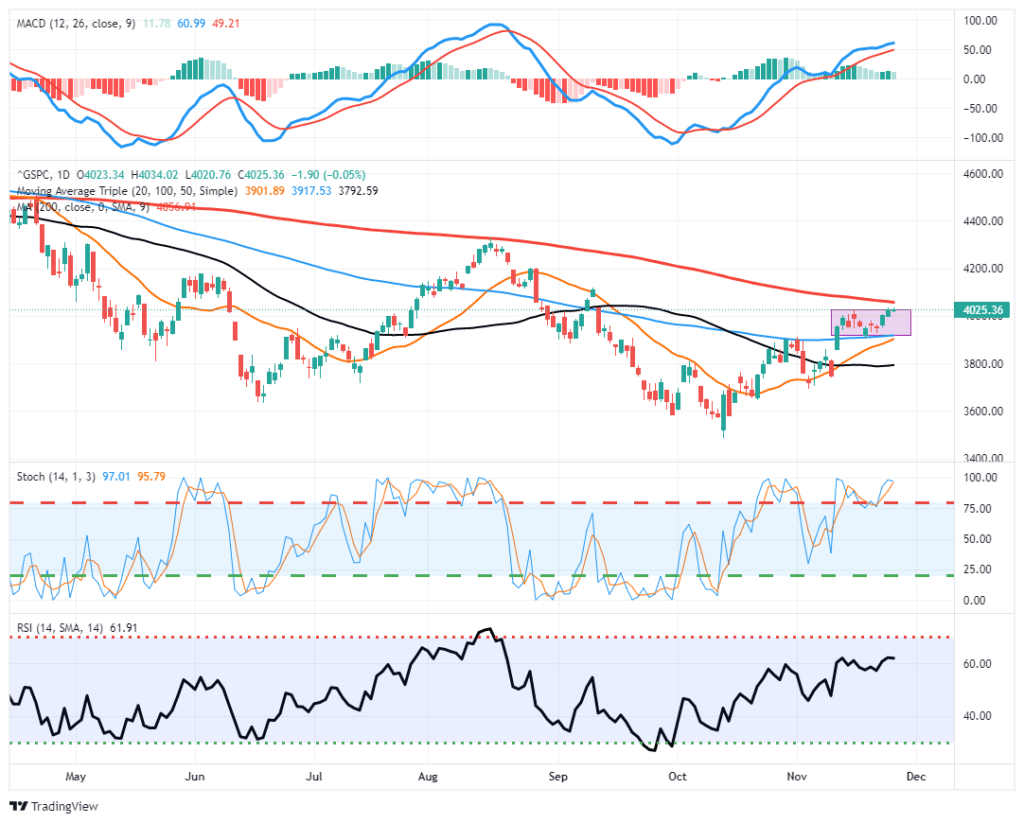
Most notably, the number of stocks trading above their respective averages continues improving. While this is bullish, it is also typical, at these levels, to align with short-term market peaks.
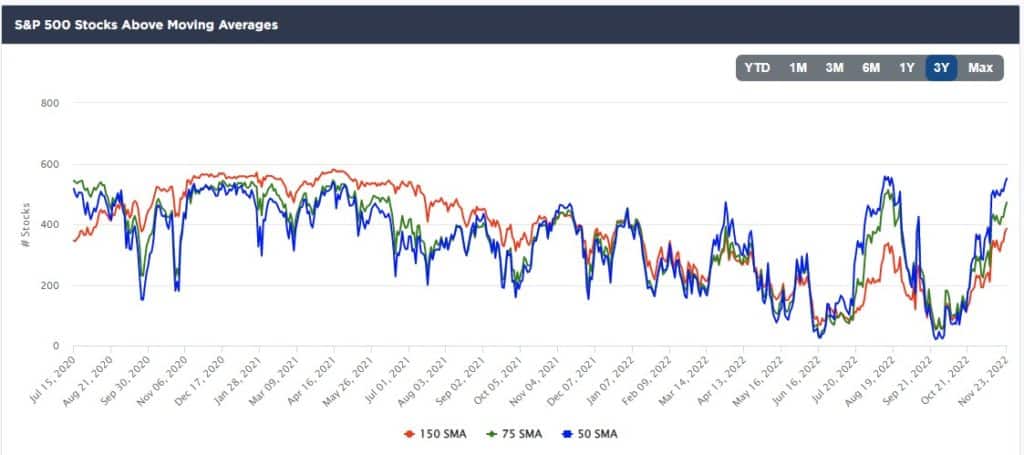
One issue challenging this rally remains the drop in the volatility index. As noted last week, net bullishness rose to the highest level since the July rally. That bullish increase coincides with a sharp decline in the volatility index as investors think the “bottom is in.“ So far this year, a reading of 20 or below has provided a good signal to take profits and reduce risk.
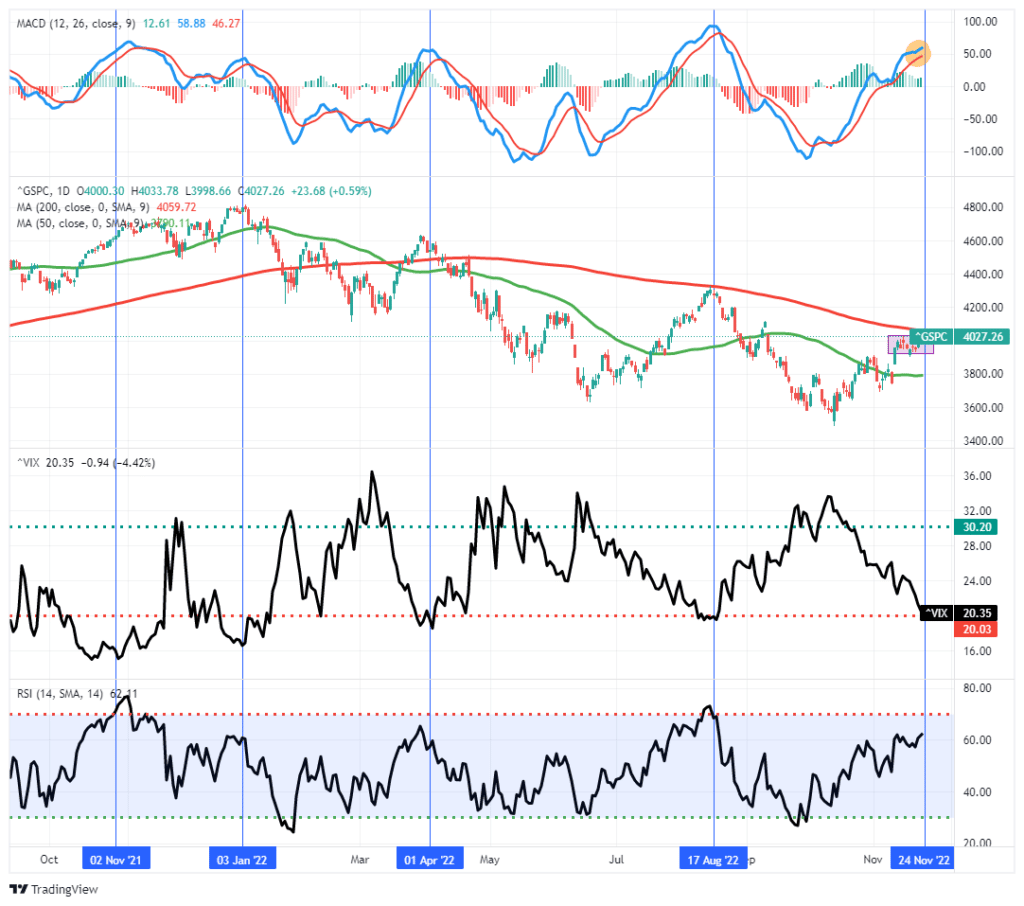
As noted, the Wednesday rally followed the release of the FOMC minutes, which read more “dovish.” While there was no mention of a “pivot” or a “stall,” investors seem to like the idea of a slower pace of rate hikes. However, traders overlooked the Fed’s statement, increasing rate hikes in 2023.
The rally reversed a majority of the previous oversold conditions and net bearishness. Therefore, some profit-taking and risk reduction in portfolios remain prudent. While the expectation for a rally into year-end remains, we could see some selling in the first half of December from tax loss harvesting and portfolio rebalancing. Such will likely provide a tradeable opportunity into year-end and the beginning of 2023.
The most prominent question investors will have to grapple with is whether there will be a recession in 2023.
Need Help With Your Investing Strategy?
Are you looking for complete financial, insurance, and estate planning? Need a risk-managed portfolio management strategy to grow and protect your savings? Whatever your needs are, we are here to help.

No Recession In 2023?
Given the most aggressive Fed rate hiking campaign in the last 40 years, it’s difficult to fathom the economy could avoid a recession in 2023. Yet, this is what Goldman Sachs recently suggested could be the case.
“While it is too early to call for a Fed pivot based on a few inflation readings that remain well above the Fed’s 2% target, our economists forecast steady declines in core PCE in 2023. They expect goods deflation and services disinflation will drive core PCE from 5% today to 3% at the end of next year (Exhibit 8). Progress in corralling inflation means the Fed will raise rates by 50 bp in December, followed by 25 bp hikes in February, March, and May that will lift the Fed funds rate to 5.0%-5.25%. The policy rate will stay high to keep growth below trend.
Importantly, under the soft landing scenario, our economists forecast below-trend GDP growth will be accompanied by just a 1/2 point increase in the unemployment rate to 4.1%, and the US economy will avoid recession in 2023.”
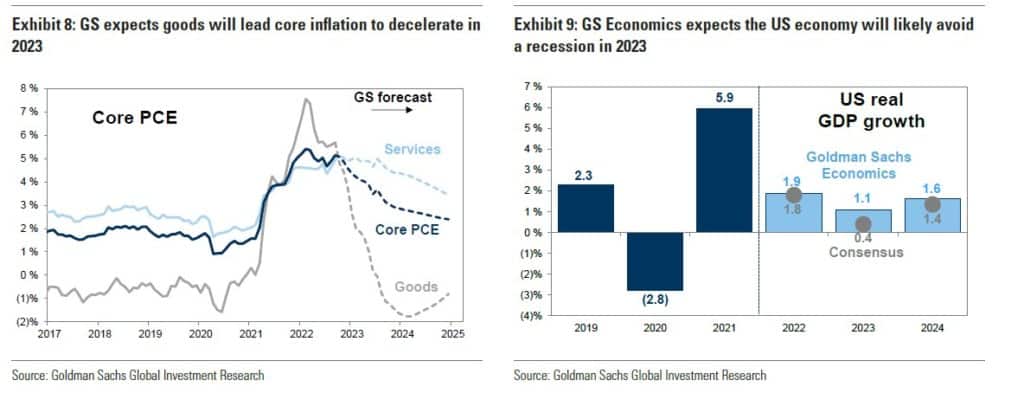
The view has important implications for equity performance next year. If there is “no recession in 2023,” then such would suggest the decline in corporate earnings and profit margins is complete. Therefore, if that is the case, then equities are also fairly valued at current levels suggesting a return of a more bullish trend next year. Such was the point made by Goldman Sachs that in the “no recession in 2023” scenario, earnings growth would be flat versus an -11% decline during a recession.
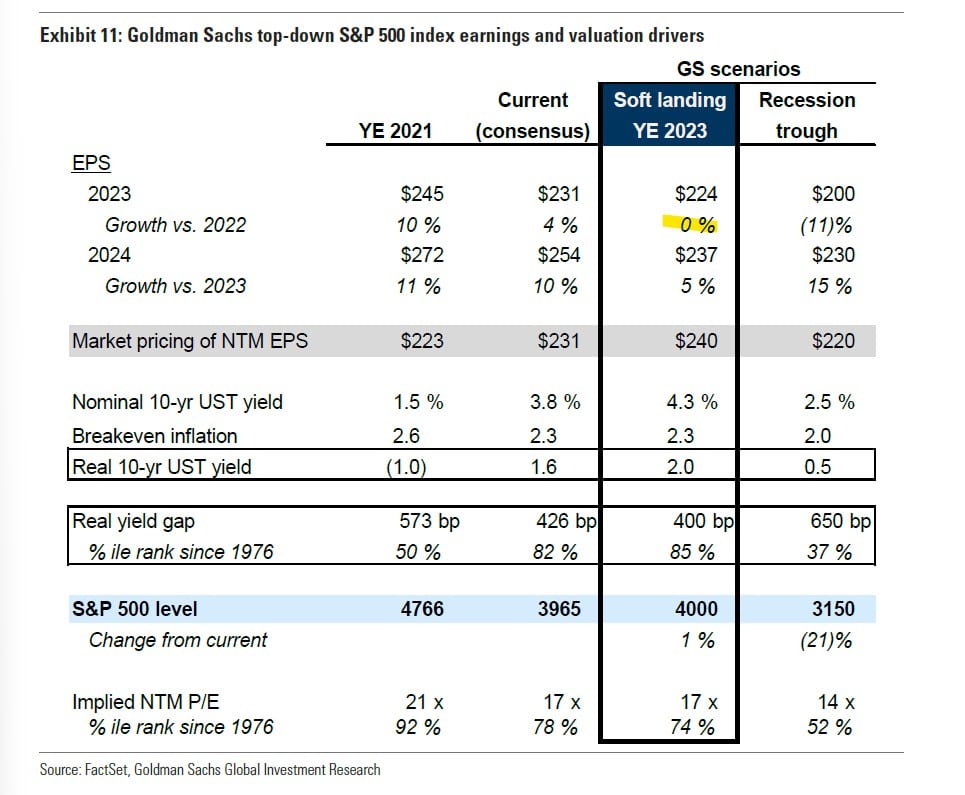
As investors, we must acknowledge the “possibility” of Goldman Sachs’ view of a soft landing scenario. However, as we will discuss next, the “probabilities” of a recession in 2023 seem far more significant. But what bothers us with the recession/hard landing view is that everyone thinks the same.
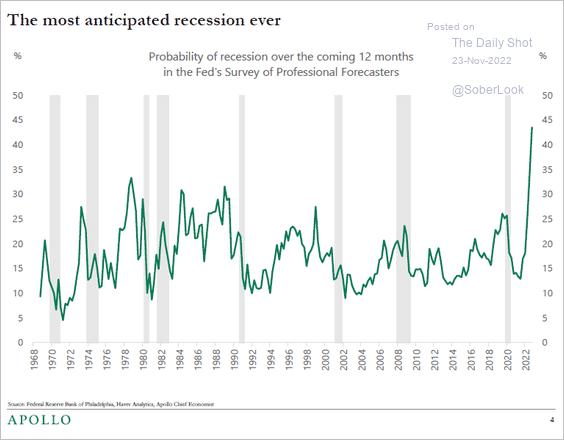
As Bob Farrell once said, “When all experts agree, something else tends to happen.”
Such is why it’s worth considering Goldman’s view, even though the risk of a recession remains elevated.
Our Base Case Still Says Recession In 2023
Neither we nor anyone else knows what will happen in the economy and markets next year. Such is why it is dangerous to invest capital in a manner that is dependent on a specific outcome. Historically, “one-sided” bets tend not to work out well and destroy significant amounts of capital.
Our job as portfolio managers is to develop a thesis and build a portfolio allocation based on that thesis. However, our most important job is to recognize when events and facts have changed and adjust our portfolios accordingly. Such is why even though our outlook remains a “recession in 2023,” with a rather significant decline in earnings, we must at least consider the possibility that Goldman Sachs is right and our view is wrong.
As noted above, the latest FOMC minutes suggest the Fed will hike 3-times in 2023. Such will bring the terminal rate to 5.25%, putting immense pressure on consumers via higher credit card payments. A slowing of activity seems inevitable since consumption is ~70% of GDP. Of course, slower economic activity means both lower revenue and declining inflation.
But such is NOT what Wall Street analysts currently expect. As shown, after the brief earnings decline in 2022, earnings will return to growth mode in 2023, rising to $204/share. Such only occurs if there is no recession in 2023, inflation falls sharply, and consumers keep spending at current rates. Instead, history suggests that earnings tend to revert to the long-term growth trend suggesting a rather significant economic contraction.

Additionally, there is a high correlation between the S&P 500 and corporate profits. Such is unsurprising since investors bid up asset prices as profitability increases. Currently, the market is overpriced relative to corporate profitability. Given the high levels of inflation, slowing consumer demand, and increased borrowing costs, a compression of corporate margins seems probable in 2023.
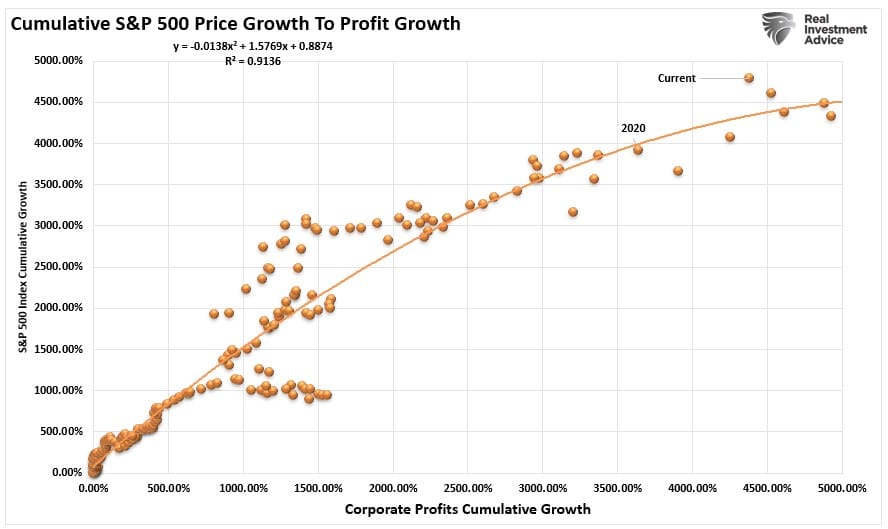
One important note is that while the Federal Reserve may slow the pace of rate hikes, they are STILL hiking rates. Hiking rates at a slower pace differs from a “pivot” where the Fed cuts rates. Given the current unemployment data, as shown, and inflation still running above 7%, well above the Fed’s target, there is no scenario where the Fed cuts rates anytime soon.
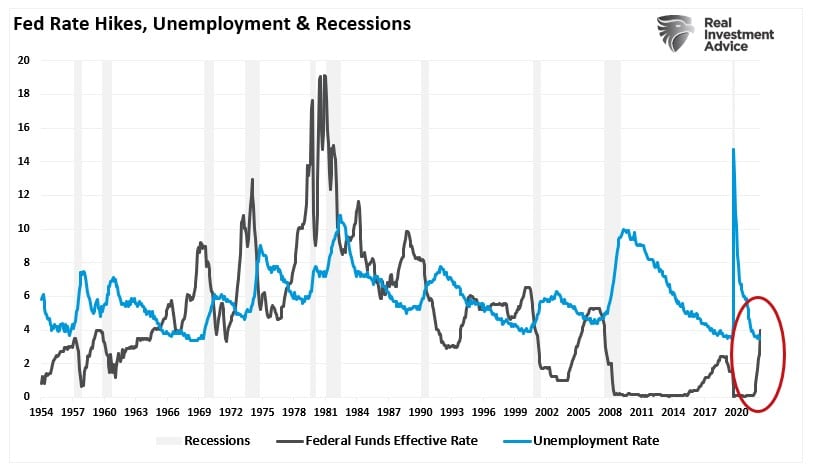
As such, the longer the Fed maintains restrictive monetary policy, the more significant the drag will be on economic growth and, ultimately, earnings.
Navigating The Recession
The risk of deeper recession remains elevated as the Fed continues to hike interest rates. Each rate hike is another weight put upon the consumer and the economy.
While the economy could avoid a “recession,” those odds are slim at best. Therefore, we should at least prepare for a storm while hoping it doesn’t come. The guidelines are simplistic but ultimately effective.
- Raise cash levels in portfolios
- Reduce equity risk, particularly in high beta growth areas.
- Add or increase the duration of bond allocations which tend to offset risk during quantitative tightening cycles.
- Reduce exposure to commodities and inflation plays as economic growth slows.
If a recession occurs, the preparation allows you to survive the impact. Protecting capital will mean less time spent getting back to even after the storm passes.
Alternatively, it is relatively straightforward to reallocate funds to equity risk if we avoid a recession or if the Fed does revert to monetary accommodation.
Investing during a recession is difficult. However, you can take some steps to ensure increased volatility is survivable.
- Have excess emergency savings, so you are not “forced” to sell during a decline to meet obligations.
- Extend your time horizon to 5-7 years, as buying distressed stocks can get more distressed.
- Don’t obsessively check your portfolio.
- Consider tax-loss harvesting (selling stocks at a loss) to offset those losses against future gains.
- Stick to your investing discipline regardless of what happens.
While the media tries to pick the next market bottom, it is better to let the market show you. You will be late, but you will have confirmation the bear market is over.
If I am correct, the recession could be worse than expected, and prices will decline further. If I am wrong, we will reallocate to equities and rebalance our portfolios for growth.
Not Getting The Bull Bear Report Each Week In Your Mailbox? Subscribe Here For Free.
How We Are Trading It
At the September lows, we suggested there was a decent probability for a strong counter-trend rally due to the extreme oversold conditions and bearish bias at the time. We specifically suggested that investors use any rally to tax-loss harvest, raise cash levels, and reduce overall portfolio risk.
In the manner of “practicing what we preach,” we have done precisely that over the last couple of weeks. We have completed most of that risk reduction and rebalancing of portfolios with our sales this past week. On Monday, we further reduced our energy holdings which have become overbought and have not yet declined with oil prices. We suspect there will be some pressure on energy stocks heading into year-end as portfolio managers rebalance sector weightings. We also removed our preferred-equity holdings for a small tax-loss harvest but will rebuild that position next year as the yield curve begins to un-invert.

While we could see a bit of a rally next week, the risk of a correction is rising.
I hope you and your families had a very Happy Thanksgiving.
See you next week.
Research Report

Market Recap – How To Set Stop Losses
Subscribe To Our Youtube Channel To Get Notified Of All Our Videos
Stock Of The Week In Review
Will return next week.
Here is a link to the full SimpleVisor Article For Step-By-Step Screening Instructions.
Login to Simplevisor.com to read the full 5-For-Friday report.
Daily Commentary Bits
Financial Stability Or Is Something Breaking?
Recently we have noted that the odds are increasing that financial instability, or as we say, “something breaks,” is the likely culprit to force the Fed to reverse course. Given the strong link between Fed policy and asset prices, it’s valuable to appreciate how the Fed monitors financial stability. The illustration below categorizes the four factors the Fed assesses in its Financial Stability Report. The red-shaded areas provide a current update on the four financial stability categories. While conditions can change rapidly, there are few signs of financial instability rearing its ugly head.
Some may argue that stock and bond prices are down 15-20%, which does not portend financial stability. However, as noted, they have been offset to some degree by rising home prices. If stock and bond prices stay down and house prices start falling as many expect, we might see one of the four financial instability measures trigger a warning. However, such would likely not be enough for a pivot unless stock and or bond prices decline further from current levels. As for the three other categories, there is nothing concerning at the moment, but conditions can change quickly.
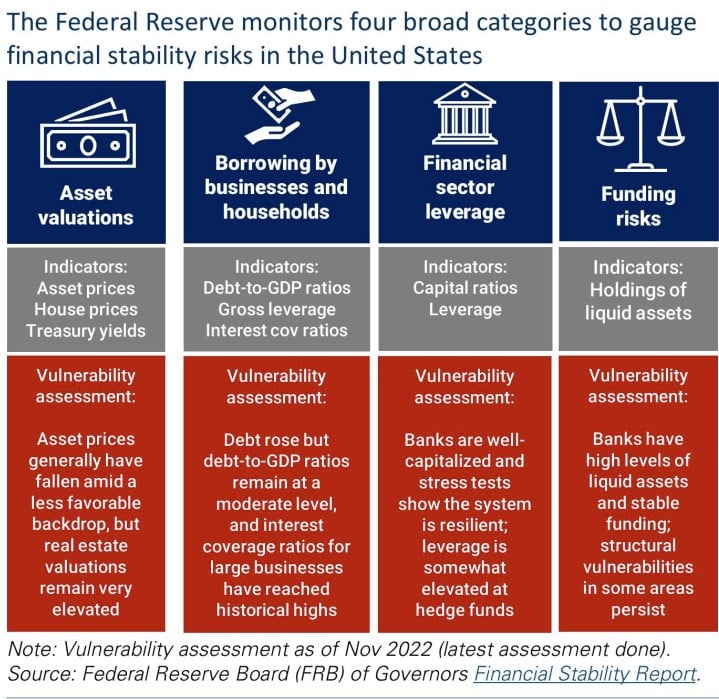
Click Here To Read The Latest Daily Market Commentary (Subscribe For Pre-Market Email)
Bull Bear Report Market Statistics & Screens

SimpleVisor Top & Bottom Performers By Sector
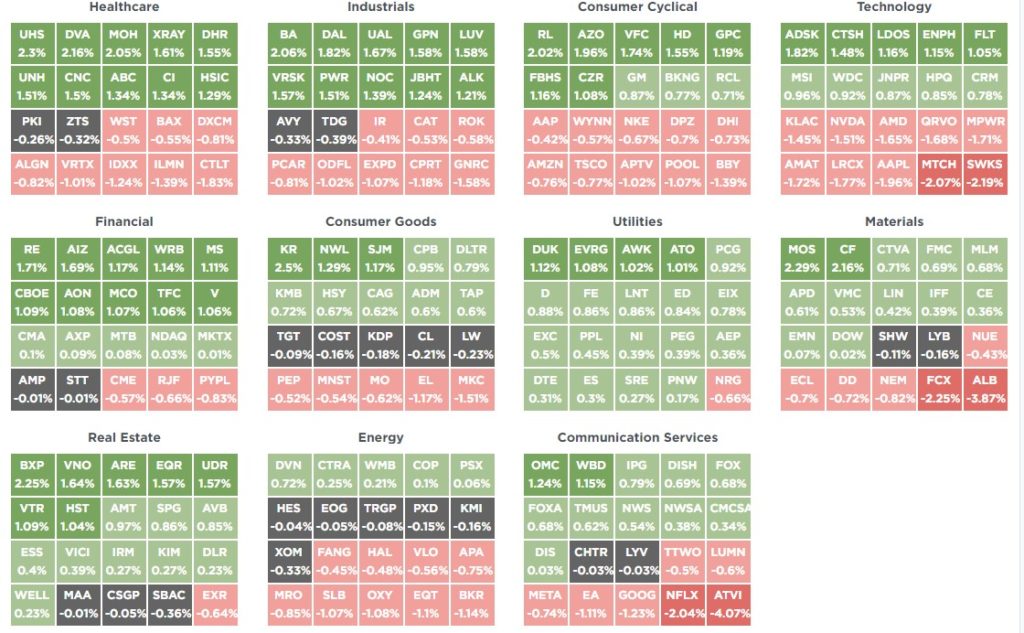
S&P 500 Tear Sheet
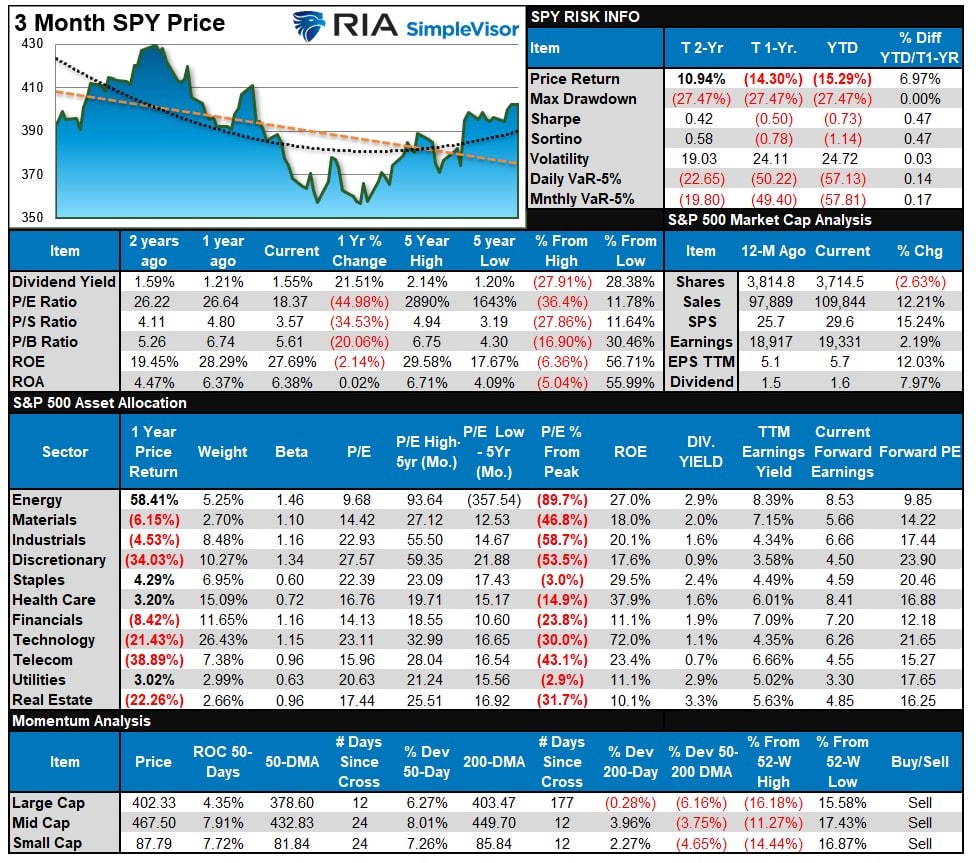
Relative Performance Analysis
The market rallied again last week post the release of the FOMC minutes. With a light volume, holiday-shortened trading week, I would read too much into the action. However, the move pushed most markets and sectors into extremely overbought territory, suggesting some profit-taking is likely well warranted.
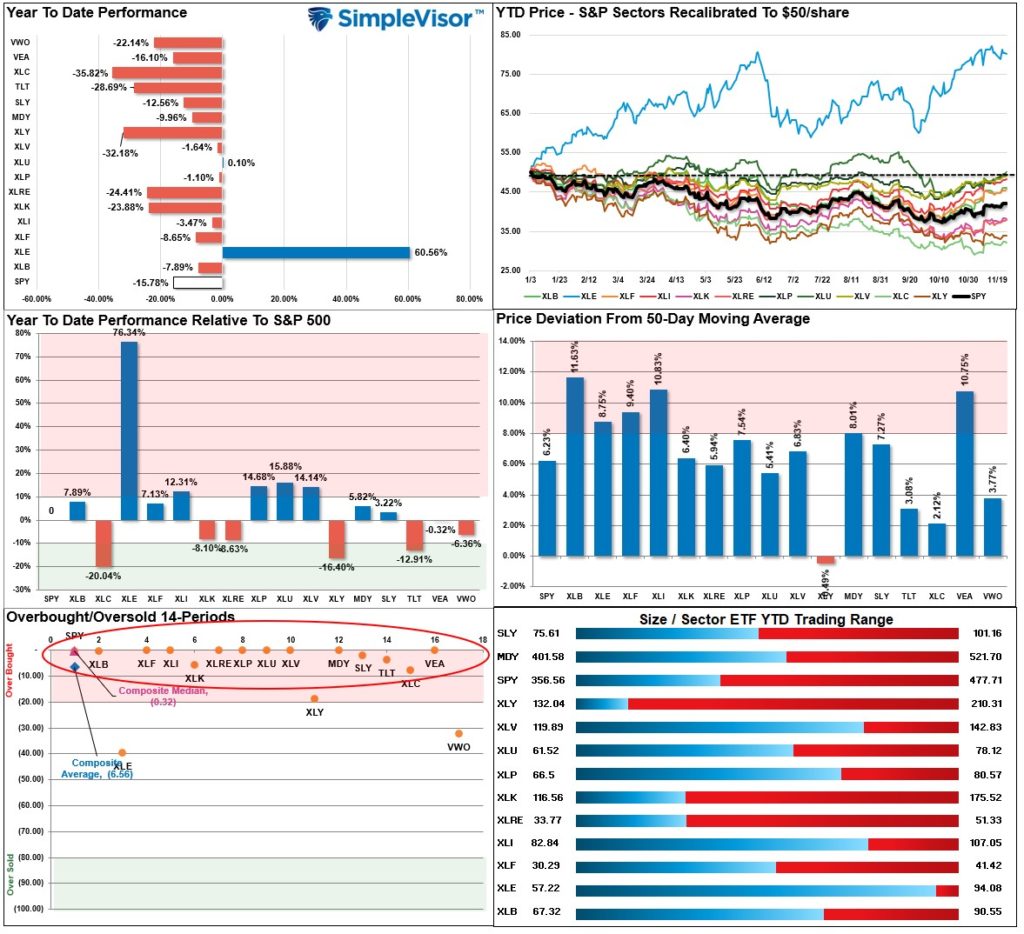
Technical Composite
The technical overbought/sold gauge comprises several price indicators (RSI, Williams %R, etc.), measured using “weekly” closing price data. Readings above “80” are considered overbought, and below “20” are oversold. Markets tend to peak when readings are at 80 or above, which suggests profit-taking and risk management are prudent. The best buying opportunities exist when readings are 20 or below.
The current reading is 55.63 out of a possible 100 and rising. Remain long equities for now.
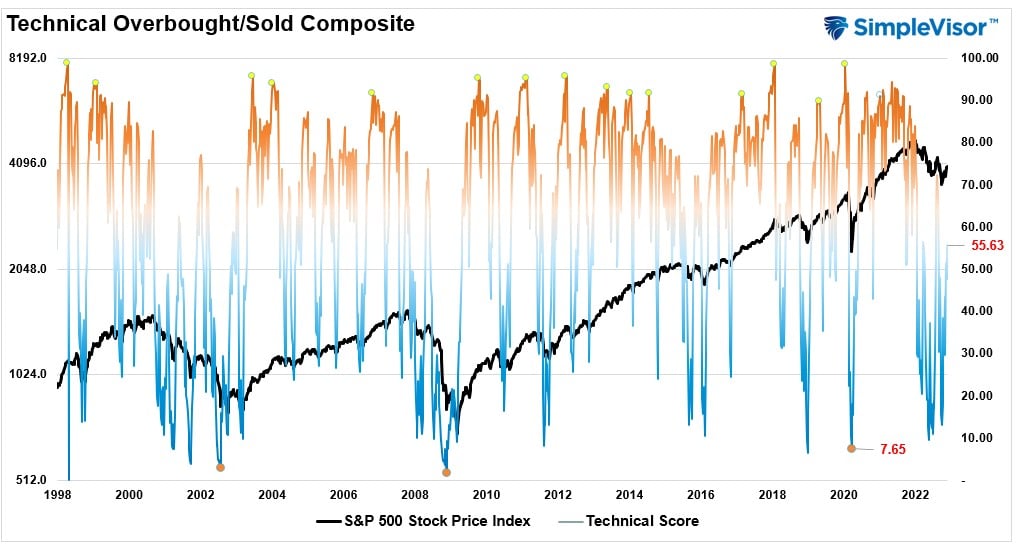
Portfolio Positioning “Fear / Greed” Gauge
The “Fear/Greed” Gauge is how individual and professional investors are “positioning” themselves in the market based on their equity exposure. From a contrarian position, the higher the allocation to equities, the more likely the market is closer to a correction than not. The gauge uses weekly closing data.
NOTE: The Fear/Greed Index measures risk from 0 to 100. It is a rarity that it reaches levels above 90. The current reading is 62.39 out of a possible 100.

Sector Model Analysis & Risk Ranges
How To Read This Table
- The table compares the relative performance of each sector and market to the S&P 500 index.
- “MA XVER” (Moving Average Cross Over) is determined by the short-term weekly moving average crossing positively or negatively with the long-term weekly moving average.
- The risk range is a function of the month-end closing price and the “beta” of the sector or market. (Ranges reset on the 1st of each month)
- The table shows the price deviation above and below the weekly moving averages.
With the rally over the last few weeks and last week’s post-FOMC minutes rise, most sectors are in more extreme overbought territory on a risk/reward basis. We suggested taking profits in last weekend’s message, which also continues this week. While markets are currently performing well, these more significant overbought conditions tend to result in near-term correction processes.
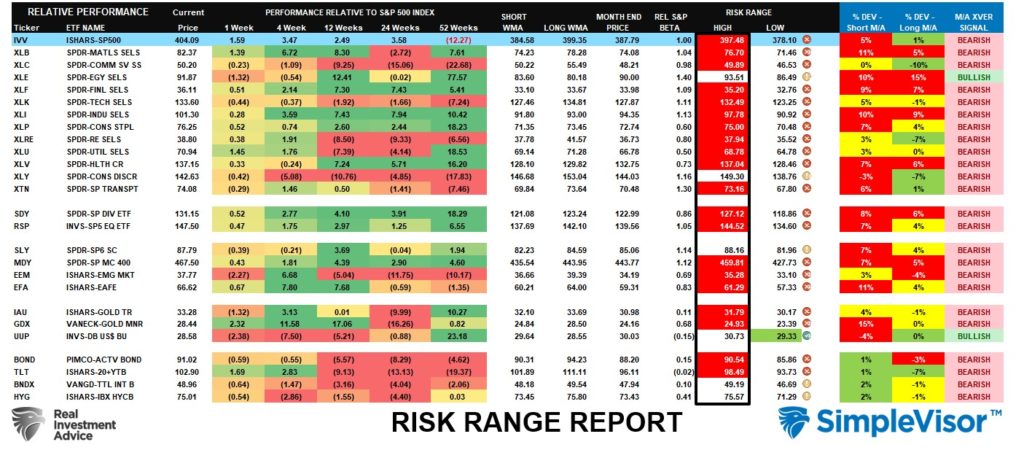
Weekly SimpleVisor Stock Screens
Each week we will provide three different stock screens generated from SimpleVisor: (RIAPro.net subscribers use your current credentials to log in.)
This week we are scanning for the Top 20:
- Relative Strength Stocks
- Momentum Stocks
- Highest Rated Stocks With Dividends
These screens generate portfolio ideas and serve as the starting point for further research.
(Click Images To Enlarge)
RSI Screen
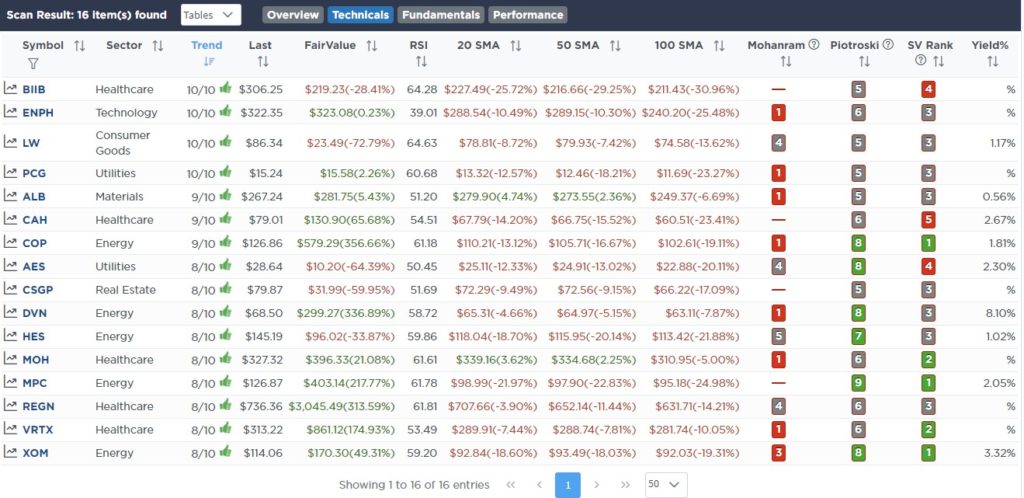
Momentum Screen
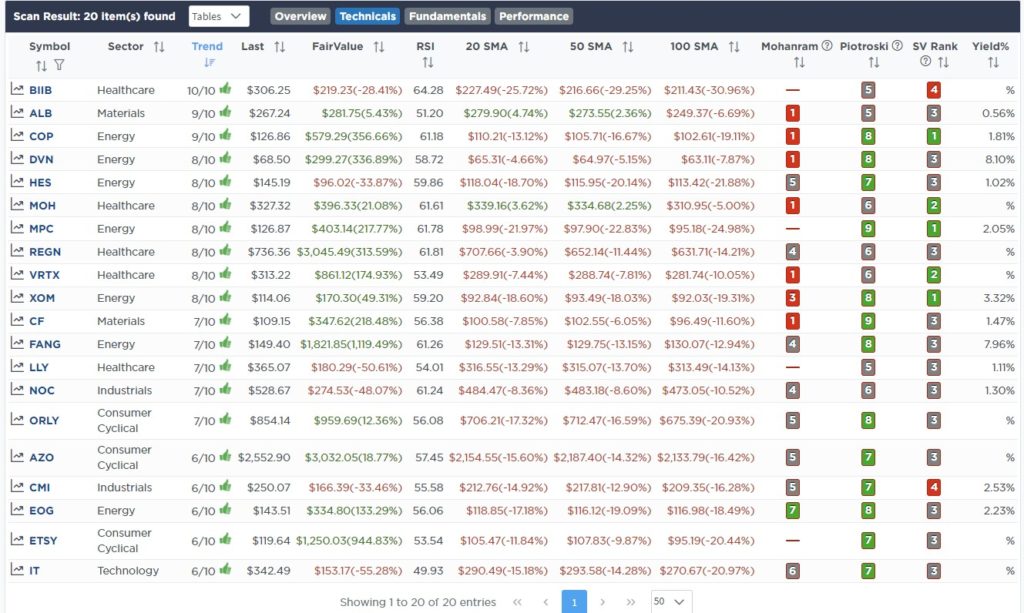
Highest Rated Stocks With Dividends
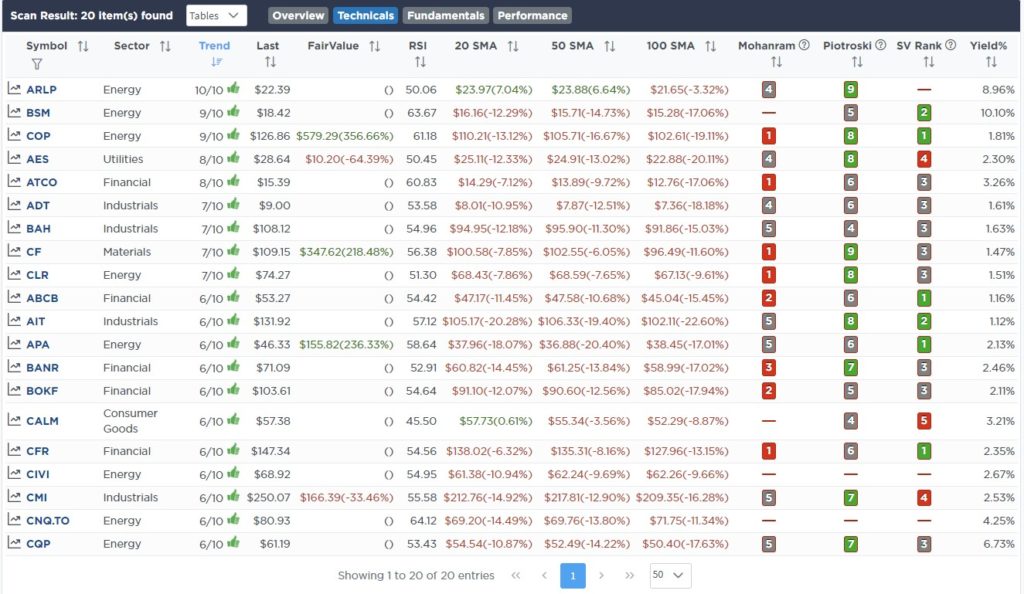
SimpleVisor Portfolio Changes
We post all of our portfolio changes as they occur at SimpleVisor:
November 21st
This morning we further reduced our energy holdings as the share prices look toppy and are turning to technical sell signals. Further, oil prices are falling much faster than energy stocks, meaning energy stocks may play some catch-up in the coming weeks. Crude is down almost 20% since early November, while XLE is down only about 5%.
We also sold 100% of PFF in both models for a tax loss harvest, and we will look to reenter the position early next year when we start aggressively adding to our longer-duration bond holdings (TLT).
Equity Model
- Reduce Exxon Mobil (XOM) and Devon Energy to 1% of the portfolio.
- Sell 100% of the Preferred Equity ETF (PFF).
ETF Model
- Reduce the iShares Energy Sector ETF (XLE) by 1% of the portfolio.
- Sell 100% of the Preferred Equity ETF (PFF).
These reductions will bring our Equity Model to 38% equity exposure and the ETF model to 42% equity exposure.

Lance Roberts, CIO
Have a great week!





















